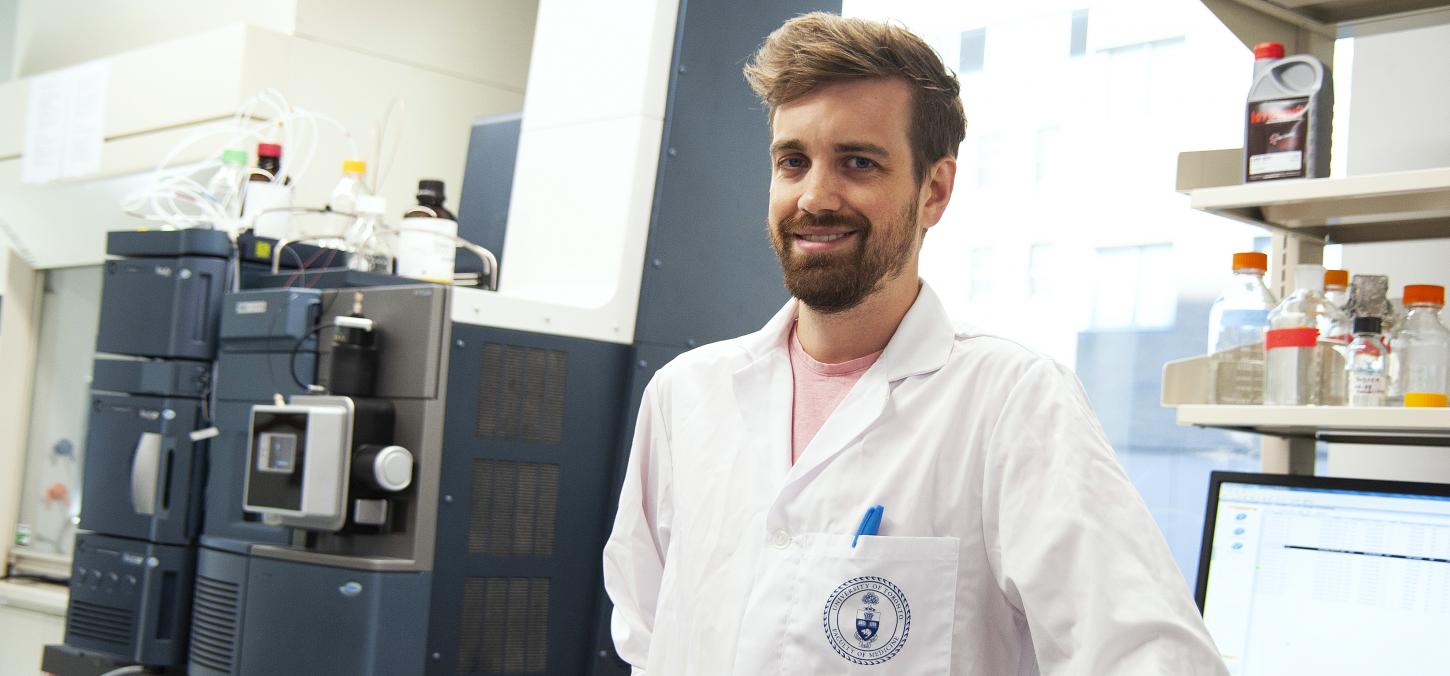
New PhD Cameron Stewart fills a gap through health tech start-up Mesosil
With his PhD from the Institute of Biomaterials & Biomedical Engineering (IBBME) fresh in hand this week, Cameron Stewart, CEO of health technology start-up Mesosil, wants to revolutionize your fillings.
Fillings—particularly newer, tooth-coloured fillings—are currently the main way to treat dental caries. And there are plenty of caries to be treated: the Canadian Health Measures Survey (CHMS) estimates that ninety-six per cent of Canadian adults will have a cavity at some point in their life. Your average Canadian kid has 2.5 of them.
Yet, no matter how perfect the bond between fillings and the tooth, bacteria eventually wedges its way in, leading to even worse infections and decay underneath the fillings and putting your teeth in peril. Most of the newer tooth-coloured fillings, says Stewart, fail within five to seven years. And replacement fillings cost Canadians an average of $3 billion a year.
But for Stewart, filling failure presents a scientific opportunity.
But the real success of the material is that it keeps on releasing its bacteria busters at a slow and steady pace.... potentially for up to a hundred years.
Over the course of his doctoral studies, Stewart, along with his supervisors, Associate Professors Yoav Finer (Faculty of Dentistry) and Ben Hatton (Department of Materials Science & Engineering), developed a novel method of engineering minute amounts of silica, commonly used to preserve things like vitamins, so that each particle is supersaturated with bacteria-fighting agents.
Loaded into a dental adhesive that keeps a filling in place, the silica-like particles releases minute amounts of bacteria busters right where it’s needed—at the 10–20 micron gap between the filling and the tooth.
“We think this is a whole new way to design materials to control drug release and prevent caries and bacterial infections for dental materials —since we know exactly where the drug is and how much is there, the release of drug can be controlled much better than if it was just randomly thrown in there,” says Hatton.
But the real success of the material -- the team has named it Mesosil -- is that it keeps on releasing its bacteria busters at a slow and steady pace.... potentially for up to a hundred years.
U-TESTED
Stewart filed a provisional patent for the material, along with an international patent application, in 2017. That same year, Stewart enrolled in UTEST (University of Toronto Early Stage Technology), a program designed to help budding entrepreneurs turn their bright ideas into marketable products and companies. The program taught Stewart a lot about how to grow his tech idea into a market-ready product, and in January 2018, Stewart formally launched the company that will get him there: Mesosil. And while the technology is still in its early phase, the results are more than promising.
“It’s really amazing,” says Stewart, who has been comparing his technology to regular fillings. “You see huge gaps opening up in normal fillings. But with ours, bacteria can’t get up in the interface.”
According to Finer, Stewart’s primary supervisor and George Zarb Nobel Biocare Chair in Prosthodontics at Dentistry, silica particles are also smart. “These materials are bio-responsive—they “sense” the presence of pathogenic bacteria and release drug in appropriate dosage to combat them.”
Now that the technology is in the “validation phase,” Stewart is keeping his eye firmly on the big picture. By next year, Stewart thinks he can start sampling the material in a retainer inserted into a human mouth. He hopes to move to clinical trials by the end of 2020.
If that seems fast, it is: Stewart’s technology can move a lot quicker into health markets than other technologies, simply because of where it will be located.
“The mouth is an easy-to-access area,” Stewart explains. “There is low risk and high rewards in this case, and finding patients will be considerably easier than a specialized application [such as a surgical implant].”
While Stewart works on proving his tech, he’s also conducting research into other health applications for the bacteria busting material, potentially rolling it into dental cements, dental sealers, or even cavity prevention products. The team is also looking at ways to incorporate the materials into the field of dental implants, where implant surfaces coated with the bacteria-busting silica could potentially prevent up to 200,000 implant failures a year.
“The materials Cameron has developed during his PhD are unique in the dental field and indeed could ‘fill the gap’ between the restoration and the tooth, and could also result in a significant reduction, perhaps the complete elimination, of antibiotics use in implant dentistry,” Finer says.
Stewart has already won several national and international awards for his research. He took second prize in the senior basic research category at the Canadian Association for Dental Research (CADR) meeting in 2017, which allowed him to present his research at the International Association for Dental Research (IADR). In 2018, he was awarded the Kulzer Travel Award from the IADR (Stewart was the only North American recipient).
“Cameron has done a fantastic job,” Hatton says. “He’s brought a materials and nanoscience background to dentistry, and achieved some really exciting, novel stuff as a result. It takes some courage sometimes to really cross disciplinary boundaries.”
But for Stewart, the real reward will come when the product betters patient outcomes. “I’m pretty confident that we have something unique here, something that can actually help people,” says Stewart.
Post-graduation, Stewart will continue his research as a postdoctoral fellow for Professor Finer.
Photo: courtesy Jeff Comber